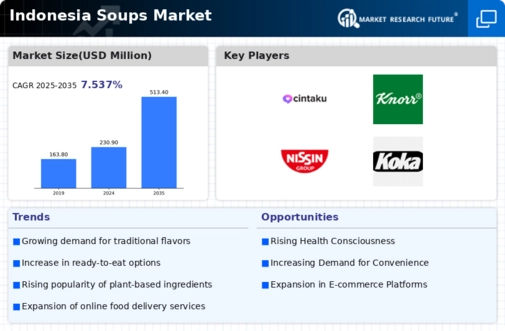Expansion of Retail Channels
The distribution landscape for the soups market in Indonesia is evolving, with an expansion of retail channels. Traditional grocery stores, supermarkets, and online platforms are increasingly offering a wide range of soup products. In 2025, online sales are projected to grow by 25%, reflecting a shift in consumer shopping habits. This diversification of retail channels enhances accessibility for consumers, allowing them to explore various brands and flavors. Furthermore, partnerships between manufacturers and retailers may lead to exclusive product launches, creating additional interest in the soups market. As a result, the competitive dynamics within the market are likely to intensify, prompting brands to adopt innovative marketing strategies.
Increased Focus on Nutritional Value
Health awareness among Indonesian consumers is influencing their purchasing decisions in the soups market. There is a growing emphasis on nutritional value, with consumers seeking products that offer health benefits. In 2025, it is estimated that around 40% of consumers prioritize soups with added vitamins, minerals, and natural ingredients. This trend suggests that manufacturers may need to reformulate their products to align with health-conscious preferences. Additionally, the rise of dietary restrictions, such as gluten-free and low-sodium options, further shapes the market landscape. As a result, brands that successfully communicate their nutritional benefits are likely to gain a competitive edge in the soups market.
Culinary Trends and Flavor Innovations
The soups market in Indonesia is significantly influenced by culinary trends and flavor innovations. Consumers are increasingly adventurous, seeking unique and authentic flavors that reflect local and international cuisines. In 2025, it is anticipated that the demand for fusion soups, combining traditional Indonesian ingredients with global flavors, will rise by 30%. This trend indicates a shift towards more diverse offerings, prompting manufacturers to experiment with new recipes and ingredients. Additionally, the popularity of plant-based and organic soups is on the rise, appealing to environmentally conscious consumers. As a result, brands that embrace culinary creativity are likely to capture the attention of a broader audience in the soups market.
Rising Demand for Ready-to-Eat Options
The soups market in Indonesia experiences a notable increase in demand for ready-to-eat products. Busy lifestyles and urbanization contribute to this trend, as consumers seek convenient meal solutions. In 2025, the ready-to-eat segment is projected to account for approximately 35% of the total soups market. This shift indicates a growing preference for products that require minimal preparation time, aligning with the fast-paced nature of modern living. Additionally, the availability of various flavors and nutritional profiles caters to diverse consumer preferences, further driving growth in this segment. As a result, manufacturers are likely to innovate and expand their offerings to meet the evolving needs of Indonesian consumers, thereby enhancing their market presence.
Sustainability and Eco-Friendly Packaging
Sustainability is becoming a crucial consideration for consumers in the soups market in Indonesia. There is a growing demand for eco-friendly packaging solutions, as consumers become more aware of environmental issues. In 2025, it is estimated that around 30% of consumers prefer products with sustainable packaging. This trend suggests that manufacturers may need to invest in innovative packaging technologies to meet consumer expectations. Additionally, brands that promote their commitment to sustainability are likely to enhance their brand image and attract environmentally conscious consumers. As a result, the focus on sustainability could reshape the competitive landscape of the soups market, encouraging more brands to adopt eco-friendly practices.















Leave a Comment